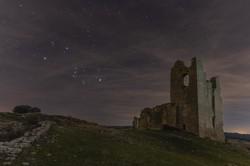Glossary term: 红超巨星
Description: 红超巨星是一种表面温度相对较低,但半径通常是太阳等主序星的几百倍甚至几千倍的恒星。较低的温度使其表面呈现红色,而较大的直径则使恒星的亮度大大超过太阳。
红超巨星的形成方式与红巨星相同,但其前身恒星的质量要大得多。 这两种类型的恒星最初都是主序星,也就是像太阳一样通过核聚变在其内核中将氢燃烧成氦的恒星(不过红超巨星的质量要比太阳大得多)。当这种恒星的氢燃料耗尽时,它就会开始将氦燃烧成更重的元素。这时,恒星会膨胀,其表面会在此过程中冷却下来,随着体积的增大,恒星会变得更加明亮。红超巨星的剩余寿命只有几万年。
猎户座的参宿四和天蝎座的天兔座就是红超巨星的例子。与红巨星一样,红超巨星也容易发生脉动和质量损失。大多数(可能是全部)红超巨星都会以超新星爆炸结束,喷出大量气体,核心坍缩形成中子星或黑洞。
Related Terms:
See this term in other languages
Term and definition status: The original definition of this term in English have been approved by a research astronomer and a teacher The translation of this term and its definition is still awaiting approval
The OAE Multilingual Glossary is a project of the IAU Office of Astronomy for Education (OAE) in collaboration with the IAU Office of Astronomy Outreach (OAO). The terms and definitions were chosen, written and reviewed by a collective effort from the OAE, the OAE Centers and Nodes, the OAE National Astronomy Education Coordinators (NAECs) and other volunteers. You can find a full list of credits here. All glossary terms and their definitions are released under a Creative Commons CC BY-4.0 license and should be credited to "IAU OAE".
If you notice a factual or translation error in this glossary term or definition then please get in touch.
Related Media
星空下的瞭望塔和稻田
Credit: Likai Lin/IAU OAU
License: CC-BY-4.0 Creative Commons 署名 4.0 国际 (CC BY 4.0) icons
猎户王国
Credit: Carlos Zudaire/IAU OAE
License: CC-BY-4.0 Creative Commons 署名 4.0 国际 (CC BY 4.0) icons










